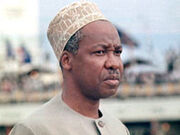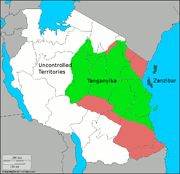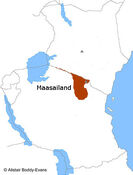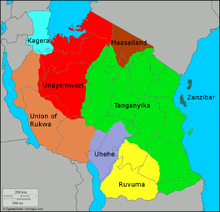| |||||||
| Capital | {{{capital}}} | ||||||
| Largest city | Dar es Salaam | ||||||
| Language official |
Swahili | ||||||
| others | English | ||||||
| Religion | Christianity, Islam | ||||||
| Demonym | Tanganyikan | ||||||
| Population | approx. 32 million (total) people | ||||||
| Independence | from United Kingdom | ||||||
| declared | December 9, 1961 | ||||||
| Currency | Tanganyikan Shilling (TGS) | ||||||
| Time Zone | East Africa Time (UTC+3) | ||||||
| Organizations | East African Community | ||||||
Tanganyika is the mainland region of the pre-Doomsday United Republic of Tanzania. After Doomsday, the Tanzanian government slowly destabilized, resulting in the formation of several breakaway states. After the Zanzibar Secession, the mainland readopted its previous name. The post-Doomsday government, now known as the Republic of Tanganyika, continues to hold sway over a majority of the country.
History[]
Pre-Doomsday[]
The territory of modern-day Tanganyika is one of the oldest inhabited areas on the Earth with records of human habitation going back over one million years. Most of the ancestors of modern-day Tanganyikans arrived about 2000 years ago during the Bantu migrations. Major civilizations, most notably Azania, existed as early as the 1st millennium C.E. and engaged in trade throughout the Indian Ocean. Arabs brought Islam and a new era in Tanganyikan history during the 2nd millennium C.E. as their traders came to dominate and convert the coastal areas. Zanzibar and areas of eastern Tanganyika came under Portuguese rule beginning in 1505, which lasted for several centuries. Finally in the early 1700s, the Omanis, together with the area's native inhabitants, overthrew Portuguese rule and Omani rule lasted until European colonization.
Throughout the 19th century, European explorers swept through Tanganyika as European powers were establishing colonies elsewhere in Africa. The Germans, British and Belgians competed for influence in modern-day Tanganyika. Ultimately in 1891, the German Empire took full and direct colonial control of Tanganyika. German colonial control continued until World War I with Germany's defeat. After the war, Rwanda and Burundi, previously territories of Tanganyika, were transferred to Belgium and the British took over administration of Tanganyika. It became a UN Trust Territory after World War II. Independence was achieved on December 19, 1963.

Julius Nyerere
On April 26, 1964, Tanganyika merged with Zanzibar to become a country that was soon known as Tanzania. This new nation was ruled by Julius Nyerere and his Tanganyika African National Union (TANU), which later merged with the dominant Zanzibaran political party to become the CCM Revolutionary party. Nyerere implemented widespread reforms under a version of African socialism known as Ujamaa. These reforms included the forced creation of collective farms and mass nationalization, which increased poverty and corruption throughout the nation. In 1979, Tanzania declared war on Uganda after a Ugandan invasion of northwest Tanzania. The Tanzania Army repelled the Ugandan invaders and, with the assistance of Ugandan rebel groups, took the Ugandan capital of Kampala and deposed the government of Idi Amin.
Doomsday[]
Like most of Africa, Tanganyika was not directly affected by the events of Doomsday. However, news of the devastation shocked much of the population. Initially, the situation remained stable and public unrest was contained by an increased police presence across the nation. Ships who occasionally docked in Tanzanian ports in the weeks after Doomsday would bring increasingly dire news about the wider world. Luckily, the Tanzanian government was able to survive the first few months after largely intact.
Anarchy[]
Due to its nonaligned status, Tanzania was not close to any of the major superpowers, though it was friendly with and received some financial support from China. However, a large percentage of its budget (30%) came from foreign aid and as those funds dried up the government became increasingly unstable. Slowly in the months after Doomsday, the government went bankrupt. Combined with the collapse of world trade, basic services, particularly those outside urban areas, began to break down. The collective farms, a centerpiece of Ujamaa, collapsed as the government was no longer able to maintain them. Thankfully, the bulk of the Tanzanian military remained loyal to the government despite the lack of pay. Despite the loyalty of the armed forces, government control began to evaporate in many areas of the country. Eventually, whole regions of the country became de facto independent as provincial or tribal governments took control. As government control collapsed, the armed forces, on the orders of Nyerere, forcibly seized direct control of large swaths of the country, triggering widespread panic. In the panic that ensued, violence broke out and several regions of the government proclaimed total autonomy or, in a few cases, independence from the faltering central government. Most of these new states attempted to claim the mantle of a new Tanzania, though none of them was able to maintain that title. Miraculously, the central Tanzanian government was able to maintain control of a large portion of the country. However, it would be many years before it fully recovered.
Secession[]

1985 Tanganyika: Green - Directly Controlled Red - Loosely Controlled Blue - Zanzibar
In the autumn of 1984, the autonomous government of Zanzibar had grown tired of the growing anarchy that was engulfing the mainland. As a result, President Aboud Jumbe of Zanzibar closed the island chain to the refugees from the mainland and declared independence as the Republic of Zanzibar and Pemba. Fortunately for Zanzibar, the central government was too weak to protest the secession as the mainland became increasingly unstable. Zanzibar then began its own path away from mainland politics as it permanently separated itself from the affairs of Tanganyika.
The Turbulent Years[]
Thanks to Doomsday, Tanzania had been cut off from its international aid donors and international markets, which had collapsed. As a result, the economy crashed, the government went bankrupt, and central authority slowly dissolved. After the military attempted to avert the collapse of the government by seizing and occupying vast swaths of the country, a panic ensued. Soon, various provinces and tribes began declaring independence or became completely autonomous. Zanzibar declared its independence. This was the beginning of years of economic depression and hardship for Tanganyika, as it was now known since the name Tanzania was dropped due to the absence of Zanzibar.
Initially, the central government attempted to force the provinces, particularly the independent ones, to submit. While there was some success, limited supplies and internal crises prevented the central government from fully reasserting its authority. Food shortages and resistance from new tribal militias ultimately stopped the government's efforts in their tracks. The military soon became involved in a series of internal political crises that shook the foundations of the ruling CCM Party and threatened to further destabilize the government. A series of rising political stars within the party challenged Nyerere and his government due to their failure to maintain control of the entire country. Ultimately the crisis was resolved in 1987 with the resignation of Nyerere and many of his top officials from government, though they kept powerful positions within the CCM. The new leaders of the Tanganyikan government strove to keep the military strong, rebuild the economy, and stabilize what territory they continued to administer, a process which would proceed into the next decade. Unfortunately, the Tanganyikan government was forced to, at least temporarily, abandon its quest to reassert its authority over the whole of Tanganyika to do this.
New Nations[]
In the years following Doomsday, several states broke away from the Republic of Tanganyika government. Some of these states were formed by tribes who wished to free themselves from the central government. Others were breakaway provinces who defected in order to better provide for themselves.
Maasailand[]

Maasailand
The Maasai are an ethnic group in the northern area of Greater Tanganyika and southern Kenya. They have historically had a strongly united pastoral, tribal society. In modern times, they have been attempting to accommodate their traditional, pastoral lifestyle with the modern, sedentary one. After the Doomsday, the Maassai, faced with increasing harassment and lack of resources from the central government launched a major revolt, which succeeded in creating a Maasai nation, known as Maasailand. The revolt began in late 1984 as other areas of the country began slipping away from the central government's control. Maasai tribal warriors, armed with weapons lost by the military and trafficked in since Doomsday, spread out across their traditional tribal areas and slowly ejected the remaining government forces in the area. In January 1985, they launched an assault against Arusha, the regional capital, in an attempt to secure it for the new Maasai nation. Unfortunately, this was a strategic error on the part of the Maasai as their offensive quickly dissolved into a guerrilla campaign that ultimate inflicted major casualties on the Maasai and failed to even reach the city. Since Maasai independence, the state has had a somewhat tense relationship with Tanganyika, and neighboring Kenya after it supported another Maasai revolt there. During the Maasai Crisis, Maasailand successfully supported a Maasai revolt in southern Kenya, which resulted in much of the Maasai-inhabited areas of Kenya to fall under the de facto control of Maasailand. After the revolt, the Maasai were relatively isolated and continue to be an aggrevator of regional conflict against Kenya and Tanganyika.
Kingdoms of Kagera[]
As one of the most remote regions of Greater Tanganyika, Kagera was one of the first provinces to break away from the central government. Initially, their autonomy came as a result of their remoteness and the inability of the central government to continue to properly administer the region. When central authority ultimately slipped away, the remaining provincial authorities attempted to maintain order. The provincial authorities were primarily represented through the six district councils: Bukoba Town, Bukoba Rural, Karagwe, Muleba, Biharamulo and Ngara. The councils attempted to organize militias, maintain social services, and assure an adequate food supply. While the councils were able to maintain stability for several years, a series of internal crises and food shortages resulted in the collapse of the regional government in 1986. After their collapse, the traditional states of Kagera was resurrected. For several centuries before Tanganyikan independence, the nine kingdoms of Kagera had maintained order in the area. These kingdoms were Kihanja, Karagwe, Kiziba, Misenye, Bugabo, Kyamtwara, Ihangiro, Bukara and Biharamulo. They continued to exist until Julius Nyerere became President and stripped them of their power. In the power vacuum after the collapse of the councils, these kingdoms were re-established. In order to maintain unity in the region, a unity government was established in Bukoba. Ironically, the Kageran government would also be a council, a nine member council, with one representative per kingdom, that would oversee issues between the kingdoms. The central government was very weak and only served to ensure cooperation between the kingdoms. The Kingdoms were able to maintain stability until the Burundi ethnic cleansing campaigns sent thousands of Hutus across the border. The waves of refugees destabilized the Kingdoms, forcing them to dramatically strengthen their border defenses and seek assistance from their neighbors. After the Rwanda-Burundi War, the flow of refugees decreased, but the new Hutu population in the Kingdoms ushered in a new era for the region.
Union of Rukwa[]
The Union of Rukwa was formed in the panic after Doomsday. At first, the government was able to manage it until the supply shortages and bankruptcy destabilized it. In a desperate move, the government attempted to occupy large swaths of the country with the Army. The attempted occupation sparked a panic, which hit the western regions of Greater Tanganyika particularly hard. Civil order slowly dissolved and governmental authority in the region disappeared. The Army, which had attempted to maintain order, could not control the situation and faced mutinies as its members from the region fled or fought their officers. In early 1985, the Army was forced to withdraw and the region was left in relative chaos. The only semblance of authority were the remaining district councils, which ruled the cities, and tribal entities, who dominated the countryside. Over the next few years, the tribes and district councils struggled to survive, while constantly clashing. By 1988, desperation, and the leadership of the Fipa tribe, forced the survivors together. In June 1988, the surviving district councils and tribes from the former regions of Rukwa, Mbeya and Kigoma came together at Sumbawanga and established a new state, known as the Union of Rukwa. The Union was established as a weak federal state that could oversee the various tribes and districts of which it was composed.
Unyamwezi[]
Unayamwezi is a multi-ethnic state formed by the five tribal groups who all consider themselves Wanyamwezi, the people of Unayamwezi. These tribes are the Kimbu, Konongo, Nyamwezi, Sukuma, and Sumbwa. Although they had never been formally united in the past, they have historically had excellent relations and cooperated extensively after Doomsday. Being located in the west-central region of the country, the Wanyamwezi were the focus of greater attention by the government than other areas, but government mismanagement and constant crisis combined with the panic that occurred after the attempted occupation push the entire region into unrest. The five Wanyamwezi tribes each revolted against government rule and pushed their forces east. After the successful rebellion, the chiefs of the five tribes, together with allied provincial and district leaders, assembled in Tabora and established a new government. The new nation, known as Unayamwezi, combined Ujamaa socialist principles, existing political structures, and tribal governance. The result was a multi-ethnic federation that managed to move through the post-Doomsday chaos and establish a semi-stable state.
Uhehe[]
Uhehe is the nation of the Hehe people, known collectively as the Wahehe, who established their independence in the turbulent years of post-Doomsday Greater Tanganyika. The Wahehe were the dominate population in the Iringa Region and were widely known as some of the strongest-willed people in Tanzania. Although they had not revolted against any central authority since the 19th century, the conditions of post-Doomsday Greater Tanganyika forced them to declare their independence from the government. In November 1984, the Wahehe rose up against the Republic of Tanganyika and rapidly secured control of the southern half of the Iringa Region, but the capital, Iringa, and the northern districts remained under tenuous governmental control. The Wahehe fought a guerrilla war against government forces until 1986 when they captured Iringa. Parts of northern Iringa remained under government control after the ceasefire. The Hehe tribal chiefs assembled in Iringa and elected a new Paramount Chief, who happened to be descended from the great Hehe Chief Mkwawa. Today, Uhehe exists in relative peace with their neighbors, though it has a fairly stubborn independent streak. It continues to claim northern Iringa and is rumored to be funding a yet-to-be unleashed insurgency in the area. It is a semi-democratic tribal federation that combines traditional tribal hierarchies with pseudo-modern intra-tribal democracy.
Ruvuma[]
Being on the Greater Tanganyikan periphery, the Ruvuma Region experienced a rapid degradation in central authority after the post-Doomsday crises of 1984. By early 1985, Ruvama had established itself as a de facto independent state, though it continued to pay some homage to a united Tangayikan nation by not declaring independence. In the chaos, the new regional militia expanded, seizing areas of the Lindi and Morogoro Regions. This expansion sparked a short war with the remnants of the Republic of Tanganyika, which pushed back the Ruvuma militias. The war caused a wave of discontent to sweep through the population, leading to the independence of Ruvuma. Since independence, Ruvuma has maintained peace with the Republican government and shows the most willingness to accept reunification of all the newly independent states. The Ruvuman government maintains most of the original regional governance bodies, with the exception of a new post of President.
Reconciliation[]
Throughout the late 1980s and 1990s, the nations of Greater Tanganyika were engaged in constant border disputes, tribal feuds and small wars. After the 1987 Tanganyikan political crisis, the Republic of Tanganyika ended their attempts to actively reconquer the entirety of Greater Tanganyika. Instead, they focused on securing areas they only had loose control over. The other nations in the region spent the early years establishing themselves, legitimizing their government and returning stability to the region. This period coincided with a substantial growth in agriculture as the collectivist farming model was abandoned for a new, decentralized cooperative farming model. While agricultural production did not create huge surpluses, it was enough to prevent widespread famine in the region. Other improvements, such as the rehabilitation of factories and mines, enabled the regional economies to experience some growth. Despite these improvements, the Tanganyikan nations continued to feud for several more years.
By 1993, the border disputes finally died down as the various military forces in the region could no longer gain ground against one another without full scale war. As no nation had the stomach or resources to reunite the country militarily, a cold peace set in across the region. Several nations began opening their borders with other nations in order to encourage trade. The Republic of Tanganyika exerted sizable economic influence over some of their smaller neighbors through their control of coastal trade, though the larger states of Rukwa and Unyamwezi remained economically independent. While Maasailand and Uhehe remained generally hostile to their neighbors, no other nation sought to generate any conflict. This period also saw the establishment of contact with new nations that had arisen in North America, Europe, and Asia and the strengthening of trade ties to nations that had survived Doomsday.
Eventually, the expanded economic ties and the lack of an appetite for warfare between the nations of Greater Tanganyikan led to the relaxation of tensions. A new era of relative peace reigned over the region. Leaders in Kagera and the Republic of Tanganyika led efforts to expand multilateral ties, which resulted in a Tanganyikan Free Trade Area (TFTA) in 1997. While calls for reunification remained distant, relations between several states continued to improve and other multilateral efforts were considered.
A New Millennium[]
The sustained peace between the various states of Greater Tanganyikan resulted in a prolonged period of peace and economic growth. After the establishment of the TFTA, many leaders in the region saw a door for even greater economic growth. Further integration was seen as an economic necessity in order to ensure access to both the coast, which was entirely controlled by the Republic, and the Great African Lakes, which had developed into a significant trading area, for all states in the region. In addition, western states, such as Kagera, were interested in increased assistance in dealing with the Rwandan-Burundi conflicts. Above all, the Republic of Tanganyika led the effort for further unification because of their continued, if more muted, desire to reunite the country. Joining together with their ally Kenya, Tanganyika promoted the re-establishment of the East African Community as a way to bring further economic, and later political and military, integration to the region. Based on previous multilateral agreements signed between various Tanganyikan states and Kenya in the mid-1990s, negotiations over the proposal began in 1998. On July 7, 2001, the East African Community (EAC) was officially re-established with Kenya and all Tanganyikan nations being members.
Overall, the 21st century has been a relatively quiet century for the Greater Tanganyikan region. Relations between the states continue to improve and cooperation between them has dramatically increased. In addition, the Tanganyikan states continue to experience fairly steady economic growth thanks largely to the recovering markets of northern hemisphere. A customs union between the states was implemented in 2007, through the EAC, which further contributed to economic growth. Issues have arisen with the issues in Rwanda and Burundi, though no solution to the conflict has been decided upon.
Government[]
The Republic of Tanganyika is a unitary presidential democratic republic, whereby the President of Tanzania is both head of state and head of government, and of a multi-party system. Executive power is exercised by the government. Legislative power is vested in both the government and parliament. The party system is dominated by the Chama Cha Mapinduzi (Revolutionary State Party). The Judiciary is independent of the executive and the legislature.
The governments of the other Tanganyikan states vary widely. While they all subscribe to some form of democracy, the specific systems differ. Maasailand is a tribal confederation with all political power invested in the various tribes. The central Kagera is a monarchical confederation with a parliamentary democracy, while each individual kingdom is typical some sort of constitutional monarchy. The Union of Rukwa and Ruvuma are one-party states with a government similar to that of Tanganyika. Unyamwezi is a multi-party democracy with authority divided between three levels of governance: the tribe, the region, and the district.
Economy[]
The economy of the region is largely based on agriculture, though the industry and services sectors have experienced continual growth. The nation has many natural resources including minerals, natural gas, and tourism. Extraction of natural gas began in the 2000s. Gas is drawn into the commercial capital, Dar es Salaam and exported to various markets overseas. The mineral sector started to pick-up slowly in the late 90s, and major discoveries are announced regularly. However, the mineral sector has yet to start contributing significantly to the overall Tanganyikan economy. On the other hand, the contribution of the tourism sector to the Tanganyikan economy is steadily rising year after year. Industry is mainly limited to processing agricultural products and light consumer goods. Tanganyika has vast amounts of minerals including gold, diamonds, coal, iron, uranium, nickel, chrome, tin, platinum, coltan, niobium, and other minerals. It is the second-largest producer of gold in Africa after South Africa and Ghana. Greater Tanganyika is also known for Tanzanite, a type of precious gemstone that is found only in area and is name for the former nation of Tanzania. Growth from 1991 to 1999 featured industrial production and a substantial increase in output of minerals, led by gold. Commercial production of natural gas from the Songo Songo island in the Indian Ocean off the Rufiji Delta commenced in 2008, with natural gas being pumped in a pipeline to Dar es Salaam, the bulk of it converted to electricity by public utility and private operators. A new gas field is being brought online in Mnazi Bay.
International Relations[]
The nations of Greater Tanganyika have various diplomatic stances. The Republic of Tanganyika and Unyamwezi maintain relations with many countries through Africa and the rest of the world. The other Tanganyikan states largely limit their diplomacy to Eastern and Central Africa. In general, most Tanganyikan states have growing relations with one another and with Kenya, with the notable exception of Uhehe and Maasailand, thanks to their membership in the East African Community. Their relations with Zanzibar are complicated. While most of the regional states are fairly cordial to Zanzibar, some, like the Republic of Tanganyika, support the Chama Cha Mapinduzi (CCM) against the Civic United Front (CUF), while others, such as Uhehe and Maasailand lend political support to the CUF. Relations with Burundi are heavily strained with all Tanganyikan nations due to their conflict with Rwanda and human rights abuses. In general, the Tanganyikan has poor relations with the DSA, Spain, Greece, and other European-led nations that have interfered in African affairs, which they sees as an injustice and insult to African dignity. Beyond Africa, Tanganyikan nations have burgeoning trade relations with much of Latin America, Asia, and Oceania as its resources are growing in demand.



